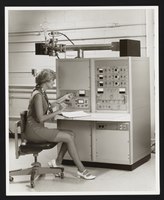
Photo from wikipedia
Mass spectrometry-based metabolomics is being increasingly applied to a number of applications, including the fields of clinical, industrial, plant, and nutritional science. Several improvements have advanced the field considerably over… Click to show full abstract
Mass spectrometry-based metabolomics is being increasingly applied to a number of applications, including the fields of clinical, industrial, plant, and nutritional science. Several improvements have advanced the field considerably over the past decade, including ultra-high performance liquid chromatography (uHPLC), column chemistries, instruments, software, and molecular databases. However, challenges remain, including how to separate small molecules that are part of highly complex samples; this can be accomplished using chromatographic techniques or through improved resolution in the gas phase. Ion mobility-mass spectrometry (IM-MS) provides an extra dimension of gas phase separation that can result in improvements to both quantitation and compound identification. Here we describe a typical drift tube IM-MS metabolomics workflow, which includes the following steps: (1) Data acquisition, (2) Data preprocessing, (3) Molecular feature finding, and (4) Differential analysis and Molecular annotation. Overall, these methods can help investigators from a variety of scientific fields use IM-MS metabolomics as part of their own workflow.
Journal Title: Methods in molecular biology
Year Published: 2020
Link to full text (if available)
Share on Social Media: Sign Up to like & get
recommendations!